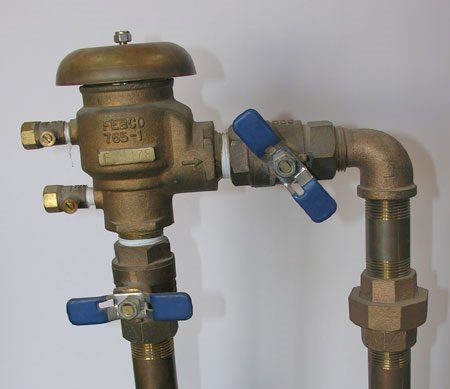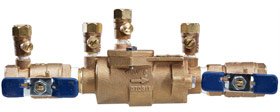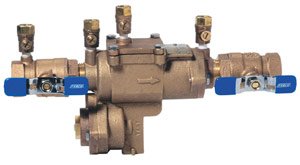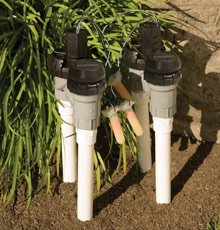What Type Of Backflow Devices Are Available?
The first sprinkler system valve unit (after the isolation valve) in a lawn irrigation system is usually the backflow prevention device. Choosing the right backflow prevention device for a particular lawn irrigation system requires careful consideration, but need not be cause for confusion.
The three most widely approved and used backflow devices are the pressure vacuum breaker assembly, the double check valve assembly, and the reduced pressure zone assembly. All three of these types are installed immediately after the irrigation system isolation valve to protect the entire irrigation system. The fourth common type of backflow device, the atmospheric vacuum breaker, is installed on each zone after the zone control valve.
Backflow Prevention Devices: Pressure Vacuum Breaker Assembly
A pressure vacuum breaker assembly (PVBA) is the most common and least expensive type of whole-systembackflow preventer. It consists of an inlet shutoff valve at the bottom; a pressure vacuum breaker, check valve, and two test cocks in a single valve body; and an outlet shutoff valve. Aside from price range, the most advantageous feature of the PBVA is its simplicity. This assembly is easy to install, maintain and repair.
Some pressure vacuum breaker assemblies have built-in freeze protection relief valves, but they only protect the assembly. Inlet and outlet water lines can still freeze if the system isn't properly winterized. PBVA will occasionally eject some water. Choose a “spill-resistant” model of PBVA for indoor installations or any time spillage would create a nuisance. An air gap drain will also be required if the valve is installed in a basement or other interior space.
 The Pressure Vacuum Breaker Assembly: The Pressure Vacuum Breaker Assembly:
- Must be installed at least twelve inches above the highest outlet on the system
- May not be used with chemigation
- Must be installed vertically (with the inlet at the bottom)
- Prevents back-siphonage only
- May not be installed where the potential for backpressure is present
Popular Major Brands:
|
Backflow Prevention Devices: Double Check Valve Assembly
The double check valve assembly (DCVA) is a good choice for underground or interior space installations. A DCVA consists of an inlet shutoff valve, two approved independently operating spring-loaded check valves (usually inside a single valve body), four test cocks, and an outlet shutoff valve. The double check valve assembly can be installed vertically if allowed by local jurisdiction.
 The DCVA is the most common type of approved backflow prevention device for use in underground lawn sprinkler systems when the backflow prevention device is to be installed inline (below grade). Some local codes require above-ground installation, so check with local authorities before proceeding. The DCVA is the most common type of approved backflow prevention device for use in underground lawn sprinkler systems when the backflow prevention device is to be installed inline (below grade). Some local codes require above-ground installation, so check with local authorities before proceeding.
It is possible to build a double check valve assembly from new components, but the risk of finding out a job-built assembly doesn't comply with local code makes this a poor choice. A more foolproof, convenient, and cost-effective option is to purchase a pre-assembled double check valve assembly.
The Double Check Valve Assembly:
- May be installed either above ground or inline (underground)
- May not be used with chemigation
- May be installed horizontally or vertically, but horizontally is preferred
- May be installed where the potential for back-siphonage or backpressure is present
Popular Major Brands:
|
Backflow Prevention Devices: Reduced Pressure Zone Assembly
The reduced pressure zone assembly, also sometimes called a reduced pressure principle assembly, is the most complex, most expensive, and, when working properly, the most secure and reliable of all backflow prevention devices. A reduced pressure zone assembly consists of an inlet shutoff valve, two independently operating spring loaded check valves with a pressure differential relief valve located between the check valves, four test cocks, and an outlet shutoff valve.
 The first check valve reduces the supply pressure so that the pressure between the check valves is always lower than the supply pressure. The relief valve between the checks—in the reduced pressure zone—adds redundant security by discharging into the atmosphere when a backflow or backpressure condition lowers the difference between the zone pressure and the supply pressure. Because the supply pressure is always greater than the zone pressure, no backflow can penetrate the upstream check even if it leaks. The first check valve reduces the supply pressure so that the pressure between the check valves is always lower than the supply pressure. The relief valve between the checks—in the reduced pressure zone—adds redundant security by discharging into the atmosphere when a backflow or backpressure condition lowers the difference between the zone pressure and the supply pressure. Because the supply pressure is always greater than the zone pressure, no backflow can penetrate the upstream check even if it leaks.
Some localities, such as Honolulu, do not allow reduced pressure zone assembly to be installed below grade in underground lawn sprinkler systems, while others require copper pipe on both ends of the assembly. Local codes may be especially variable and stringent on reduced pressure zone assembly, so have a thorough understanding of local requirements before proceeding.
Reduced pressure zone assemblies come in a variety of configurations. Choose an “inline” or “straight” configuration for installation underground. For above-ground installation, consider an “n” configuration assembly for a very small footprint.
The Reduced Pressure Zone Assembly:
- May be installed above ground or inline, but above ground is preferred
- May be used with chemigation
- Must be installed horizontally unless factory-configured for alternate installation
- May be installed where the potential for back-siphonage or backpressure is present
Popular Major Brands:
|
Backflow Prevention Devices: Atmospheric Vacuum Breaker (Anti-Siphon)
 The atmospheric vacuum breaker is the simplest and least expensive backflow prevention device for one or two-zone anti-siphon irrigation systems. It is also the least reliable and least often recommended. Most large cities and suburbs do not allow the use of atmospheric vacuum breaker in lawn sprinkler systems. Atmospheric vacuum breakers cannot be used where they would be subjected to constant pressure, where shutoff valves would be located downstream, where there is a potential for backpressure, or on any system that incorporates chemigation techniques. An atmospheric vacuum breaker uses a check float to prevent backflow. Forward flowing pressure pushes the check up out of the water pathway and into position to seal the air gap. When forward flowing pressure stops, a potential backflow condition exists. The check then drops into the water pathway, opening the air gap under the bonnet to break siphonage. The atmospheric vacuum breaker is the simplest and least expensive backflow prevention device for one or two-zone anti-siphon irrigation systems. It is also the least reliable and least often recommended. Most large cities and suburbs do not allow the use of atmospheric vacuum breaker in lawn sprinkler systems. Atmospheric vacuum breakers cannot be used where they would be subjected to constant pressure, where shutoff valves would be located downstream, where there is a potential for backpressure, or on any system that incorporates chemigation techniques. An atmospheric vacuum breaker uses a check float to prevent backflow. Forward flowing pressure pushes the check up out of the water pathway and into position to seal the air gap. When forward flowing pressure stops, a potential backflow condition exists. The check then drops into the water pathway, opening the air gap under the bonnet to break siphonage.
The Atmospheric Vacuum Breaker Assembly:
- Must be installed at least six inches above the highest outlet In the zone
- May not be used with chemigation
- Must be installed vertically with the bonnet on top
prevents back-siphonage only
- May not be installed where the potential for backpressure is present
- Requires one unit per zone—must be installed downstream from zone control valves
- Do not use where it will be under continuous pressure for more than 12 hours at a time because the disc float assembly may stick or become dented and thus become unable to protect the water supply
Popular Major Brands:
|
|